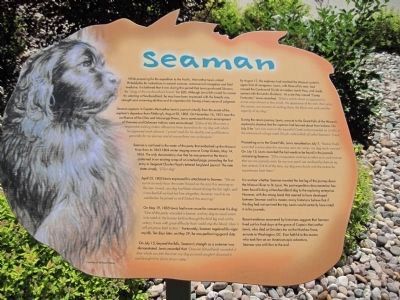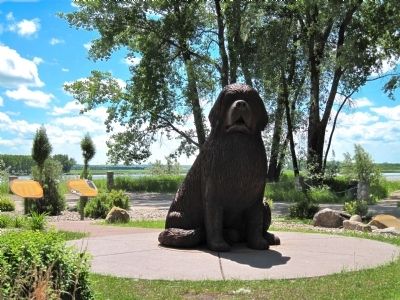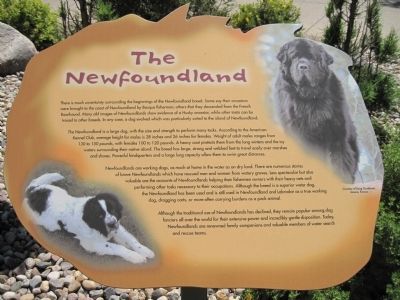Near Washburn in McLean County, North Dakota — The American Midwest (Upper Plains)
Seaman
Inscription.
While preparing for the expedition to the Pacific, Meriwether Lewis visited Philadelphia for instructions in natural sciences, astronomical navigation and field medicine. It is believed that it was during this period that Lewis purchased Seaman, his ”dogg of the Newfoundland breed,” for $20. Although Lewis left unsaid his reason for selecting a Newfoundland, he may have been impressed with the breed’s size, strength and swimming abilities and its reputation for having a keen sense of judgment.
Seaman appears in Captain Meriwether Lewis’s journal virtually from the outset of the explorer’s departure from Pittsburgh, August 30, 1803. On November 16, 1803 near the confluence of the Ohio and Mississippi Rivers, Lewis mentioned that an encampment of Shawnee and Delaware Indians were encountered. ”[O]ne of the Shawnees a respectable looking Indian offered me three beverskins for my dog with which he appeared much pleased…I prised much for his docility and qualifications generally for my journey and of course there was no bargain.”
Seaman is not listed in the roster of the party that embarked up the Missouri River from its 1803-1804 winter staging area at Camp Dubois, May 14, 1804. The only documentary clue that he was present at the time is contained in an existing scrap of an interleaf page, preceding the first entry in Sergeant Charles Floyd’s tattered longhand journal. The note states simply, ”[O]ur dog”
April 25, 1805 Lewis expressed his attachment to Seaman. ”We set out at an early hour. the water friezed on the oars this morning as the men rowed…my dog had been absent during the last night, and I was fearfull we had lost him altogether, however, much to my satisfaction he joined us at 8 Oclock this morning.”
On May 19, 1805 Lewis had more cause for concern over his dog: ”One of the party wounded a beaver, and my dog as usual swam in to catch it; the beaver bit him through the hind leg and cut the artery; it was with great difficulty that I could stop the blood; I fear it will yet prove fatal to him.” Fortunately, Seaman regained his vigor rapidly. Ten days later, on May 29, he was performing guard duty.
On July 15, beyond the falls, Seaman’s strength as a swimmer was demonstrated. Lewis recorded that ”Dreywer [Drouillard] wounded a deer which ran into the river. my dog pursued caught it drowned it and brought it to shore at our camp.”
By August 17, the explorers had reached the Missouri system’s upper limit of navigation. Lewis, with three of his men, had crossed the Continental Divide at modern Lemhi Pass, and made contact with the Lemhi Shoshoni. At a site they named “Camp Fortunate,” Lewis remarked, ”[E]very article about us appeared to excite astonishment in ther minds; the apperance of the men, their arms, the canoes, our manner of workin them, the black man york and the segacity of my dog.”
During the return journey, Lewis, enroute to the Great Falls of the Missouri, explored a shortcut that the captains had learned about from Indians. On July 5 he ”saw two swan in this beautiful Creek and proceeded on 3 miles to the entrance of a large creek 20 yds. wide [which I] Called Seamans’ Creek.”
Proceeding on to the Great Falls, Lewis remarked on July 7, ”Reubin Fields wounded a moos deer this morning near our camp. my dog much worried.” On July 15, Lewis recorded the last words to be found in the journals concerning Seaman. ”[T]he musquetoes continue to infest us in such manner that we can scarcely exist; for my part I am confined by them to my bier at least 3/4 th of the time. my dog even howls with the torture he experiences from them.”
It is unclear whether Seaman traveled the last leg of the journey down the Missouri River to St. Louis. No post-expedition documentation has been found linking a Newfoundland dog to the exploring enterprise. However, with the strong bond that seemed to have
developed between Seaman and his master, many historians believe that if the dog had not survived the trip, Lewis would certainly have noted it in his journals.
Recent evidence uncovered by historians suggest that Seaman lived out his final days at the grave of Captain Meriwether Lewis, who died at Grinders Inn on the Natchez Trace, enroute to Washington, DC. Ever faithful to his master who took him on an American epic adventure, Seaman was with him to the end.
Topics and series. This historical marker is listed in these topic lists: Animals • Exploration • Waterways & Vessels. In addition, it is included in the Lewis & Clark Expedition series list. A significant historical month for this entry is April 1752.
Location. 47° 17.849′ N, 101° 5.292′ W. Marker is near Washburn, North Dakota, in McLean County. Marker is located in Fort Mandan Park off of county road 17, approximately 2 1/2 miles north of the intersection of US 83 and ND 200A. Touch for map. Marker is in this post office area: Washburn ND 58577, United States of America. Touch for directions.
Other nearby markers. At least 8 other markers are within 3 miles of this marker, measured as the crow flies. Fort Mandan (a few steps from this marker); Bicentennial Wagon Train Pilgrimage to Pennsylvania (about 500 feet away, measured in a direct line); Below the Freezing Point (about 500 feet away); a different marker also named Fort Mandan (about 500 feet away); Men of Worth (about 500 feet away); Mandan Winter / Harmony Park (approx. 2.2 miles away); Early Boats on the Missouri (approx. 2.3 miles away); The Washburn Plant (approx. 2.3 miles away). Touch for a list and map of all markers in Washburn.
Credits. This page was last revised on October 30, 2019. It was originally submitted on July 26, 2010, by David Bullard of Seneca, South Carolina. This page has been viewed 1,477 times since then and 9 times this year. Last updated on October 1, 2010, by William J. Toman of Green Lake, Wisconsin. Photos: 1, 2, 3. submitted on July 26, 2010, by David Bullard of Seneca, South Carolina. • Bill Pfingsten was the editor who published this page.


